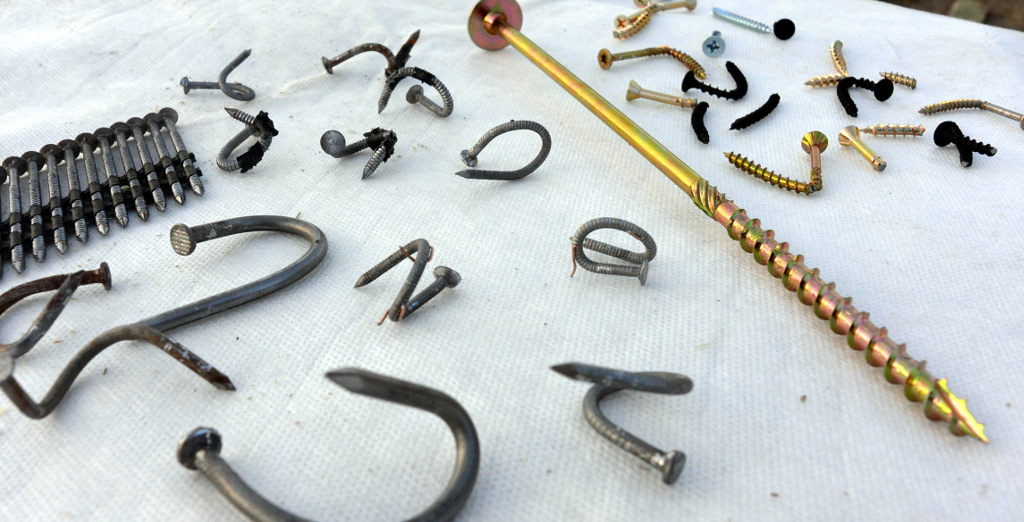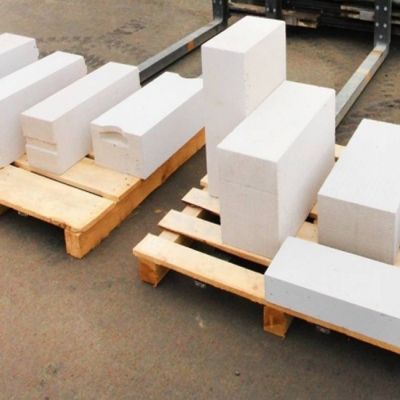What are modern nails?
Nails are smooth, ring-shank and screw-shank (they are “twisted”).
Smooth-shank nails rely on friction between the wood fibers and the shank for holding power, which is sufficient in a lot of conditions but not all. In applications where wood is routinely expanding and contracting due to moisture, wood fibers lose contact with the shank and significantly reduce the nail’s withdrawal strength. The International Code Council classify smooth-shank nails as “common” and screw- or ring-shank nails as “deformed.”
Screw-shank nails sometimes referred to as spiral-shank nails, turn as they are driven into wood.
According to the Forest Products Laboratory, ring-shank nails have twice the withdrawal strength of smooth-shank nails. As the nail penetrates into the wood, its fibers lock into each groove along the shank, resulting in a nail that holds tight despite extreme wind or cyclical moisture conditions.
All varieties of nails are uncoated (black) or zinc-coated. There are nails with other types of coating, but not for our tasks. The protective coating protects the steel from oxidation and rusting.
In addition to conventional nails sold in bulk, there are also so-called "machine" nails for use with automatic tools.
The tool for hammering such machine nails (nailer) is either electric (for small nails) or pneumatic. Nail guns are divided into two main types: round head and clipped head. Clipped head nailers are ideal for high volume projects because they can hold more nails.
Round head framing nailers are not restricted by certain building codes but hold fewer nails.
There are also "small" pneumatic hammers (they are also palm nailers), with which you can hammer ordinary single nails.
Smooth nails are usually used by a company of only large sizes to assemble a rafter system. For the assembly of structures made of self-supporting insulated wires, she universally uses ring-shank or screw nails, hammering them with a pneumatic tool
.
What are the differences between the use of nails and screws?
We will describe all the significant factors.
In North America (in the USA and Canada), vast experience has been gained in low-rise wooden construction, and it is foolish not to use it.
Many American regulations governing low-rise wooden construction (and they are there both general, federal level, and their own in each state) generally do not provide for the use of self-tapping screws.
New homes in North America are usually inspected by a building inspection. And in the North American forums on construction, there are frequent descriptions of cases when inspectors do not accept houses in the load-bearing nodes of which self-tapping screws are used.
Simpson StrongTie is one of the most famous and respected brands of fasteners for wooden structures. Only a few years ago, this brand began to introduce special screws into its range. Most of their perforated fasteners, until recently, provided for fastening to wood only with the help of ring-shank nails, and at the moment this method is the main one.
In general, the right SIP builders in North America have nails - as a rule, screws - a rare exception for special cases.
Now we will analyze in more detail the features of different solutions.
The benefits of assembling a frame for nails
Faster and more convenient to nail boards with nails
Tightening the screw at least at the beginning of the process requires two hands - you need to hold the screw and the screwdriver. To hammer a nail with the help of a "nailer" (nailing gun) is easy and with one hand - just put the gun to the material, holding the trigger. For the same time, you can hammer 6-7 nails or tighten one screw. Using an automatic nailing tool speeds up the entire construction process.
We are all human, especially builders. Laziness, the desire to save effort - an integral property of man. The fact that it takes more effort to tighten the screws when assembling the SIP-house, leads to the fact that the distance between the screws naturally increases, and more often gaps occur. It is easier to work with nails, and as a result, the build quality is higher.
In the process of tightening the screws, some of them will inevitably fall to the floor. Whether they will be picked up, or simply swept out with garbage - is unknown. Nails from the pneumatic tool do not fall anywhere - one more factor of the economy.
Nails are more flexible and hold more securely
In the process of assembling the house, its decoration and at the beginning of the operation, the load on all structural elements gradually increases. In addition, even chamber-dried wood, which is used to assemble the panels, subsequently still slightly leads.
As a result, panels and wood parts can be displaced relative to each other. There is a significant load on the fasteners.
Here it should be briefly noted that the characteristics of the metal used for the production of nails and screws are different. Nails are made of relatively soft, ductile metal. Metal for the manufacture of screws must have much greater hardness. It is impossible to make a screw soft, it will be unsuitable for screwing - the thread will smooth out and the slot will be torn off.
In an effort to reduce costs, most of the screws out of production are hard but brittle. In Russia, it is quite difficult to buy screws that do not suffer from excessive fragility. And their strength will need to be controlled in each batch. Especially should be avoided the most common, black phosphate drywall screws, the load characteristics of which are very low.
There are high-quality screws in nature that have both strength and some elasticity, but in general - this is more a happy exception than the rule.
Nails are produced by technology, which implies significant elasticity of the metal. It is simply not possible to make nails out of brittle metal.
In addition, if you take a nail and a screw of the same external diameter of the rod, the strength of the screw will be greatly weakened by the grooves of the thread.
Self-tapping screws break, nails only bend
Why it is important: with excessive load across the axis, the screw either tears the material or breaks itself. At the same time, the nail bends, but keeps the connection “to the last”. Even if mistakes are made in the construction of the building or during its operation, it is much better when they appear gradually ("beam tilts"), and not suddenly ("beam collapsed").

Nails cause fewer cracks in lumber
This is not an obvious phenomenon, but it nevertheless takes place. The edge of the nail, when rapidly penetrating deep into the wood, cuts its fibers more intensively. The tip of an ordinary screw, as it were, spreads the wood fibers, creating excessive pressure in the material. This often leads to the formation of cracks. Moreover, usually, this cracking is delayed until the final drying of the wood in the finished structure. The mounting foam does not fill these cracks.
Nails are less damaged
Even with a protective coating, screwed screws rust much more intensively than nails with a similar coating.
The fact is that the path of movement of any point on the surface of the screw in the wood is much longer, and the protective coating is damaged more intensively. And long screws also become very hot during the twisting process. It is usually recommended not to screw the screws at maximum speed, pre-drill holes for them, lubricate each screw or hole for it before tightening. On the scale of professional construction, no one will naturally deal with this. Accordingly, the same protective coating (for example, zinc) that you paid for when buying screws will work worse than the same zinc on nails.
By the way, on most of the nails for the pneumatic tool, you can see a thin layer of yellowish mass. This is a special viscous lubricant that covers the nail shaft when driving it.
Nails are cheaper
Everything is simple here. Comparison of prices for high-quality self-tapping screws, and for similar-sized nails for pneumatic tools - clearly in favor of nails. This is not the most noticeable item of construction costs, but nevertheless, we also save the customer’s money on this.
However, screw fasteners also have positive aspects.
THE ADVANTAGES OF USING SCREWS
Screws hold the pulling loadout better
If the load is applied along the axis, to pull out, the screw, of course, can withstand it better than a smooth nail. (But note that using a brushed nail changes this.)
In addition, if you hammer in nails in such a way that they have to bear a significant axial load, it means that you (or the author of the project on which you are building) are doing something wrong. Classical, centuries-tested approaches to frame construction provide for the application of a load on nails only on the cut, but not on pulling out.
Screws can be removed
Yes, an improperly screwed screw is easy to unscrew (until it is rusted). Smooth nails are a little harder to extract, you need to pick up the hat somehow, and usually, the surface of the material suffers in the process. The brushed nail, even with a protruding hat, is very difficult to remove. For beginners, it is better to use screws for building houses from SIP panels, at least at the initial stage. In case of an error, the structure can be disassembled with minimal damage to the panels.
Operation of pneumatic tools requires experience
The operation of a pneumatic tool used for assembly on nails requires attention, skill and a number of additional "tricks" from the screw. This is especially evident in winter. However, we fully cope with these difficulties. For seasonal workers, this, of course, is not an option.
Where are the competitors?
As a result, due to the correct use of ruffled nails and pneumatic tools, you will build a house quickly, and customers receive better and less expensive houses than their competitors.



